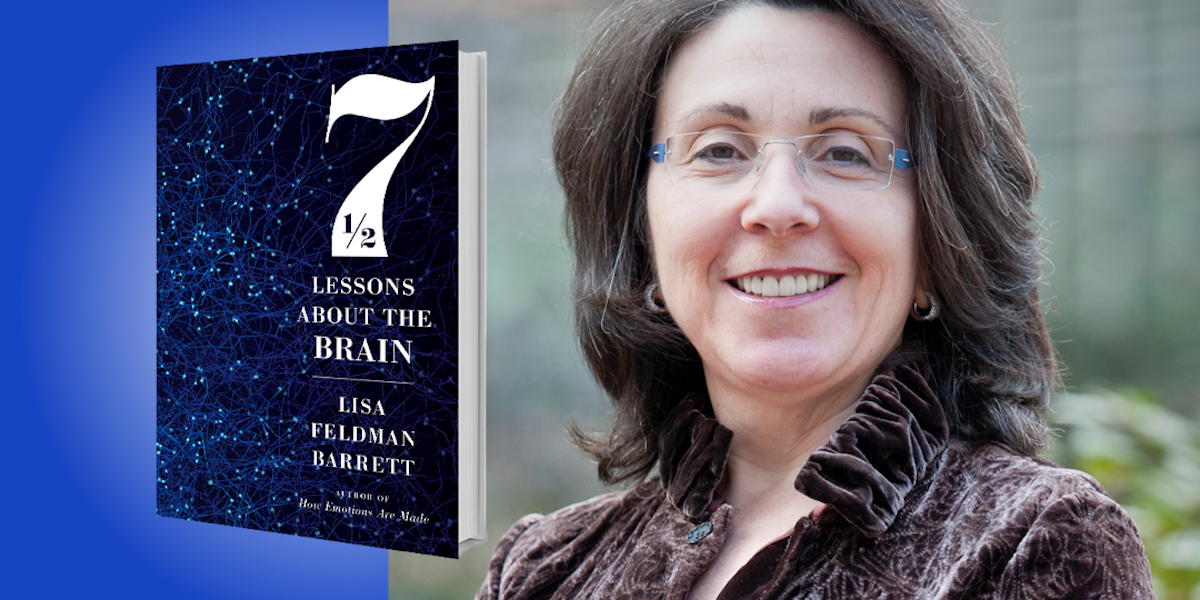Lisa Feldman Barrett is among the top 1% most cited scientists in the world for her revolutionary research in psychology and neuroscience. She is a University Distinguished Professor at Northeastern University with appointments at the Massachusetts General Hospital and Harvard Medical School. Dr. Barrett was awarded a Guggenheim fellowship in neuroscience in 2019, and she is a member of the American Academy of Arts and Sciences and the Royal Society of Canada.
Below, Lisa shares 5 key insights from her new book, Seven and a Half Lessons About the Brain. Download the Next Big Idea App to enjoy more audio “Book Bites,” plus Ideas of the Day, ad-free podcast episodes, and more.
1. Your brain is not for thinking.
The most important job that your brain has is not thinking, or feeling—it’s not even seeing, hearing, tasting or smelling. The most important job that your brain has is regulating the systems of your body. Everything you think and feel, imagine and do and see is in the service of that regulation. This insight offers the opportunity to better understand some of the major challenges that face us today, like depression, Alzheimer’s disease, and the fact that mental and physical illnesses really have deep, common metabolic causes and that social stress can make people more vulnerable to viral infections.
2. The only animal with a lizard brain is a lizard.
Have you ever heard that lurking deep inside your brain is some ancient lizard brain, an inner beast, which occasionally hijacks the rest of your brain causing you to do things and say things that you will later regret? Your “inner lizard” is very popular. It constantly makes appearances in news stories about the brain, in expensive executive training programs, and it’s the basis of modern economic theory and the legal system. The problem is that it’s also a myth. The myth that human brain contains an inner lizard, which occasionally wrests control away from your rational self, can be traced all the way back to Plato.
“You and I—and even a lizard—have the same brain plan as a blood-sucking lamprey.”
In the early to mid-20th century, when neuroscientists studied the brain largely by looking at different brains of different animals with the naked eye, it appeared as if primate brains had parts that rodent brains didn’t, and that rodent brains had parts that lizard brains didn’t. But since the 1970s, scientists have had ways of peering deep into the molecular structure of brain cells called neurons to see the genes and other genetic material inside. What we’ve learned is that all vertebrates—animals with a backbone—share the same brain plan. You and I—and even a lizard—have the same brain plan as a blood-sucking lamprey.
3. Little brains wire themselves to their world.
An infant brain is not a miniature adult brain—it’s a brain awaiting a set of wiring instructions so that it can complete its development. Where do those wiring instructions come from? They come from the infant’s experiences, which arise largely from the infant’s caregivers. Every cuddle you give an infant, every word you speak to an infant, everything you do with an infant wires that infant’s brain. We all know that it’s important how we treat our children, but it’s remarkable the extent to which an infant’s experiences, particularly with its caregivers, set that infant’s brain on a developmental trajectory to become the person who that infant will become.
Now you might ask yourself, well, don’t we have genes that specify how a brain develops? The answer is yes, we have genes for a basic brain plan, but we have the kind of genes that require certain sets of experiences, including certain social experiences, in order for a brain to develop normally and well. We have the kind of nature that requires nurture. Once you understand the extent to which a baby’s brain is born under construction, you will never look at an infant in the same way again.
“We have the kind of nature that requires nurture.”
4. Your brain does not react—it predicts.
When you drink a glass of water because you’re thirsty, your thirst seems to disappear, but it takes about 20 minutes for water in your stomach to make its way into your bloodstream and to signal to your brain that you now have enough water. So your thirst is quenched approximately 20 minutes before your brain realizes that the osmolarity of your blood has changed. How can it happen so quickly? Because your brain knows from past experience that drinking water leads to quenching your thirst. Your brain is predicting what’s going to happen next and what you should do about it rather than reacting to what you see and hear or drink.
From the minute that you’re born, your brain is trapped in a dark silent box called your skull. Your brain is receiving sense data from the world continuously, waves of light, changes in air pressure, and so on. These sense data are the effects of some set of causes in the world, but your brain doesn’t have access to the causes. It only has access to the effects. How does your brain know what you should do next when all it has are the effects and it has to guess at the causes? Well, your brain can reinstate experiences from the past. Your brain, figuratively speaking, asks itself: The last time I was in this situation when I received this array of sense data, what caused that sense data? What did I do next? What did I see next? What did I hear next? In effect, that’s what your brain is doing all the time. It’s using your memory to make guesses about the meaning of the sense data so that it knows what to do next to keep you alive and well.
“Words have a direct effect on your brain activity and your bodily systems.”
All of this guessing happens completely outside of your awareness, and the really remarkable thing is that it’s making these guesses before the sense data ever arrive. Your brain is constantly talking to itself from the moment that you’re born until the moment that you die, and those conversations are predictions about what you’re going to see in the next instance, what you’re going to hear in the next instance, how are you going to feel and what you’re going to do.
5. Words can have a powerful effect on your body.
Many species, including humans, regulate one other’s nervous systems. Ants, bees, and other insects do this using chemicals such as pheromones. Mammals like rats and mice use chemicals to communicate by smell, and they add vocal sounds and touch. Primates like monkeys and chimpanzees also use vision to regulate each other’s nervous systems. Humans are unique in the animal kingdom, however, because we also regulate each other with words. A kind word may calm you, as when a friend gives you a compliment at the end of a hard day. A hateful word from a bully may cause your brain to predict threat and flood your bloodstream with hormones, squandering precious bodily resources.
Words can have such powerful effects in part because many brain regions that process language also control the insides of your body, including major organs and systems. These brain regions guide your heart rate up and down. They adjust the glucose entering your bloodstream to fuel your cells. They change the flow of chemicals that support your immune system. The power of words is not a metaphor. Other people’s words have a direct effect on your brain activity and your bodily systems, and your words have that same effect on other people. Whether you intend that effect is irrelevant—it’s how we’re wired.
For more Book Bites, download the Next Big Idea App today:






























